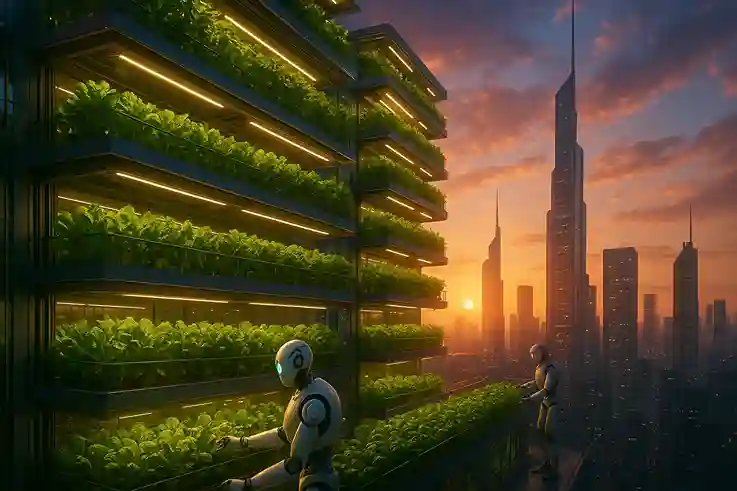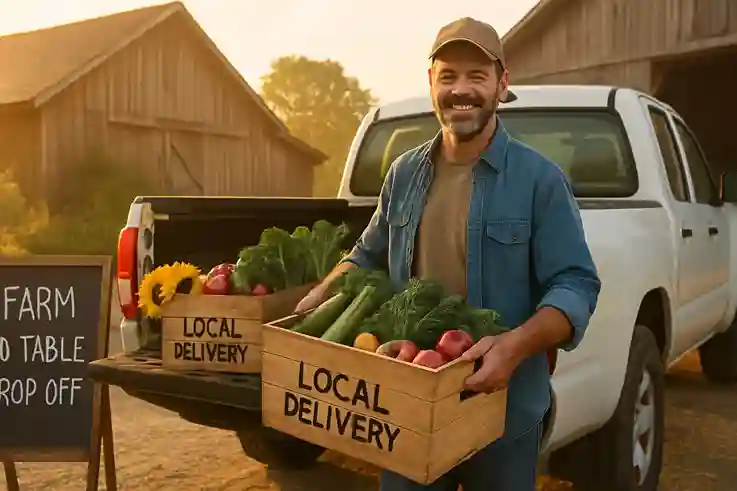What Is Vertical Farming
What is vertical farming? It is a method of cultivating crops in stacked layers, usually in controlled indoor environments. This approach often uses soilless techniques like hydroponics, aeroponics, or aquaponics, delivering nutrients via water or mist instead of soil. Vertical farming also relies on artificial lighting, temperature regulation, and automation to maximize plant growth.
The concept of vertical farming first appeared in the early 20th century. However, it gained traction in the 1990s when researchers began exploring food production inside cities. In the 2010s, technological advances in LED lighting, environmental sensors, and data-driven agriculture enabled vertical farms to scale. Today, the method is used to grow fresh produce year-round in urban and semi-urban settings.
Vertical farming differs significantly from traditional farming. Conventional agriculture spreads horizontally over large plots of land and depends on natural sunlight, weather, and seasonal cycles. In contrast, vertical farming compresses space vertically and eliminates the need for soil or sunlight. It offers precision control over variables like pH, temperature, humidity, and nutrient delivery.
It also differs from greenhouse farming. Greenhouses typically rely on natural light and partial environmental control. Vertical farms are fully enclosed systems with artificial lighting and complete climate regulation. This allows consistent crop production, regardless of external weather conditions.
Vertical farming is especially suited for urban settings. Warehouses, shipping containers, and even repurposed office buildings can become productive food hubs. These farms reduce the need for long-distance transport and can be placed near or inside population centers, offering fresh food with a smaller ecological footprint.
By decoupling food production from land and climate, vertical farming is reshaping agriculture for the modern world.
Why Vertical Farming Is Gaining Global Attention

Global interest in vertical farming is growing rapidly. This shift is driven by urgent food system challenges that demand innovative agricultural solutions.
The world’s population is projected to exceed 9.7 billion by 2050. With more people to feed, demand for fresh, reliable food sources is increasing sharply. Traditional farming methods may not keep pace, especially as yields are threatened by soil degradation, extreme weather, and pests.
At the same time, arable land is shrinking. Urban development, industrial expansion, and soil exhaustion reduce the land available for farming each year. Additionally, agriculture consumes nearly 70% of the world’s freshwater. With water becoming scarcer in many regions, more efficient farming models are essential.
Urbanization is another key factor. Over 55% of the world’s population lives in urban areas today, and that number is expected to rise. Transporting food from distant rural farms to cities increases carbon emissions and causes spoilage. Vertical farming provides a local alternative. It enables food to be grown near or even within cities, shortening supply chains and improving access to fresh produce.
Finally, consumers are demanding more sustainable food systems. Vertical farms produce with less water, no chemical runoff, and a smaller land footprint. These advantages align with public goals for environmental health and climate resilience.
Main Types of Vertical Farming Systems
Vertical farming uses different soilless systems to deliver nutrients directly to plants. Each method offers distinct benefits, costs, and technical requirements. Here are the primary systems used in vertical farming:
Hydroponics: The Backbone of Vertical Farming
Hydroponics is the most widely adopted system in vertical farming. It allows plants to grow in a soilless environment where their roots are suspended in a water-based solution enriched with essential nutrients.

How It Works
In hydroponic systems, plants receive all required minerals through a precisely calibrated nutrient solution. This mixture typically contains macronutrients like nitrogen (N), phosphorus (P), and potassium (K), as well as micronutrients like calcium, magnesium, iron, and zinc. The solution is continuously circulated to maintain oxygen levels and prevent stagnation.
Root Support Mediums
Since there is no soil, roots are supported by inert materials that do not interfere with nutrient balance. Common substrates include:
- Rockwool: Lightweight, porous, and retains moisture well.
- Clay pellets (LECA): Reusable, offer good aeration and drainage.
- Coconut coir: Organic, sustainable, and retains water efficiently.
These mediums keep the plant stable while allowing free access to nutrients and oxygen.
System Variations
Hydroponics includes several subtypes based on water flow:
- Nutrient Film Technique (NFT): A thin film of water flows over the roots.
- Deep Water Culture (DWC): Roots float in oxygenated nutrient solution.
- Ebb and Flow: Water periodically floods and drains the grow bed.
Each method has unique infrastructure and monitoring requirements, but all follow the core principle: soil-free, water-based nutrient delivery.
Why It’s Popular
Control: Farmers can adjust pH, electrical conductivity (EC), and nutrient composition in real time.
Efficiency: Hydroponics uses up to 90% less water than traditional farming.
Yield: Plants grow 30–50% faster due to direct nutrient access.
Aeroponics

Aeroponics: Precision Through Air and Mist
In aeroponics, plants grow without soil or any solid medium. Their roots are suspended in air inside a closed chamber and regularly misted with a fine spray of water enriched with essential nutrients.
How It Works
Aeroponic systems deliver nutrients directly to exposed roots via high-pressure mist nozzles. These mist intervals are carefully timed, often controlled by sensors and timers, to maintain optimal moisture, oxygen, and nutrient levels.
This direct exposure to air ensures maximum oxygen availability to roots, which accelerates metabolic activity and improves nutrient uptake.
Water and Resource Efficiency
Aeroponics is the most water-efficient vertical farming method:
- Water savings: Uses up to 95% less water than traditional farming.
- Minimal runoff: Closed-loop systems reduce waste and eliminate soil leaching.
- Efficient nutrient use: Nutrient delivery is finely tuned, minimizing excess.
Growth and Performance
Due to abundant oxygen and precise nutrient delivery, aeroponics often supports:
- Faster growth rates than hydroponics.
- Stronger root development, since roots are unrestricted by substrates.
- Cleaner produce, as there is no soil to introduce pathogens or debris.
System Complexity
Despite its efficiency, aeroponics is also the most technically demanding:
High initial cost: Infrastructure includes misting chambers, pumps, reservoirs, and monitoring sensors.
Advanced controls: Misting cycles, nutrient concentrations, and air humidity must be tightly managed.
Risk of failure: Interruptions in misting can quickly lead to root dehydration and plant stress.
Aquaponics: A Symbiotic Farming Ecosystem
Aquaponics combines two systems—aquaculture (raising fish) and hydroponics (growing plants without soil)—into one integrated vertical farming model.
In this closed-loop system, fish waste supplies nutrients for plant growth, and in return, the plants help purify the water for the fish. It’s a balanced, sustainable method that mimics natural ecosystems.

How It Works
- Fish tanks house aquatic animals like tilapia or catfish.
- Fish excrete waste, primarily ammonia, which builds up in the water.
- Beneficial bacteria in a biofilter convert ammonia into nitrates—a form of nitrogen plants can absorb.
- The nutrient-rich water flows to plant beds, feeding crops.
- Filtered water returns to the fish tanks, completing the cycle.
This process creates a naturally fertilized, recirculating water system.
Resource Efficiency and Sustainability
- Low water use: Over 90% less water than traditional soil farming.
- Minimal input waste: Fish waste becomes plant food; plants clean the water.
- No synthetic fertilizers: The system is organic by design.
- Dual yield: Produces both fish protein and fresh vegetables/herbs.
Challenges and Considerations
Disease risk: If not managed well, disease can affect both fish and plants simultaneously.
Complex balance: Maintaining proper conditions for both fish and plants can be technically challenging.
Higher startup costs: Requires tanks, pumps, filters, and dual monitoring systems (water pH, ammonia, temperature).
Species limitations: Not all fish or crops thrive in closed-loop systems.
Soil-Based Indoor Setups (Optional but Viable)
While hydroponics, aeroponics, and aquaponics dominate vertical farming, soil-based indoor systems offer a more traditional approach. Though less common, they remain relevant for certain crops and small-scale growers.
How They Work
These setups involve stacked grow beds filled with soil or compost. Artificial grow lights simulate sunlight, and irrigation systems provide consistent moisture. Environmental controls regulate temperature, humidity, and ventilation to support plant health.
Why Use Soil Indoors?
- Familiarity: Ideal for growers more comfortable with soil-based cultivation.
- Microbial diversity: Soil hosts beneficial microbes that naturally aid plant health.
- Crop suitability: Root vegetables and fruiting plants often perform better in soil than hydroponic media.
Limitations
- Space demands: Soil is heavier and requires deeper containers, making stacking more complex.
- Increased maintenance: More prone to pests, mold, and nutrient imbalances.
- Water usage: Less efficient than hydroponic or aeroponic systems.
- Soil degradation risk: Indoor soil may compact or lose nutrients over repeated cycles.
Best Use Cases
- Small vertical farms growing crops like tomatoes, carrots, or herbs where taste and texture are top priorities.
- Educational or community setups teaching traditional growing methods in controlled environments.
While not the most efficient method, soil-based systems can complement high-tech vertical farming, especially when diversity and soil biology are priorities.
Comparison Table: Vertical Farming Systems
| System | Water Use | Nutrient Source | Complexity | Common Crops | Maintenance |
|---|---|---|---|---|---|
| Hydroponics | Low | Artificial nutrient mix | Moderate | Lettuce, herbs, greens | Medium (pH, EC levels) |
| Aeroponics | Very Low | Misted nutrient solution | High | Leafy greens, microgreens | High (timing systems) |
| Aquaponics | Moderate | Fish waste (natural) | High | Leafy greens, herbs | High (fish + plants) |
| Soil-Based | Moderate | Organic soil + additives | Low | Tomatoes, peppers, herbs | High (soil care) |
Each system has advantages depending on goals, budget, and technical skill. For beginners, hydroponics offers a balance of efficiency and simplicity. More advanced users may explore aeroponics or aquaponics for greater sustainability.
Benefits of Vertical Farming
Vertical farming is redefining food production with efficient, sustainable systems that address today’s environmental and urban challenges. Here are the key benefits that make it an increasingly attractive solution worldwide.
1. Year-Round Production
Vertical farms operate in controlled environment agriculture (CEA) systems. These facilities maintain consistent temperature, humidity, light, and CO₂ levels using automated technology. Because conditions are fully managed, crop cycles are no longer dependent on outdoor seasons or regional climates.
LED lighting simulates optimal sunlight spectrums, while environmental sensors regulate airflow, nutrient delivery, and photoperiods. This precision enables crops to grow continuously and predictably.
📌 Result: Instead of one or two harvests per year—as in traditional farming—vertical farms can achieve 8–12 crop cycles annually, depending on the species. This consistent yield contributes to reliable local food supplies, reduces import dependency, and helps stabilize market prices.
Moreover, year-round cultivation benefits urban areas that lack access to fertile land or seasonal diversity. It ensures food availability even during droughts, floods, or supply chain disruptions.
2. Drastic Water Savings
One of the most critical advantages of vertical farming is its exceptional water-use efficiency. Compared to conventional field agriculture, these systems can reduce water usage by up to 95%.
In hydroponic and aeroponic systems, water is recycled in closed-loop cycles. Plants receive only the amount of water they need, and any excess is captured, filtered, and recirculated. This process drastically minimizes evaporation, runoff, and waste, which are major concerns in traditional irrigation methods like flood or sprinkler systems.
📌 Result: Every drop of water is optimized for plant uptake, making these systems ideal for drought-prone or arid regions where freshwater availability is declining.
3. Space Efficiency
Vertical farming is fundamentally designed to maximize productivity in minimal space. By stacking crops vertically—using shelves, hydroponic towers, or wall-mounted systems—growers can significantly increase the yield per square foot compared to horizontal field farming.
📌 Key Insight: One acre of vertical farm space can produce yields equivalent to 10–20 acres of traditional farmland. This efficiency depends on crop type, system design, and the number of vertical layers used.
This stacking approach is particularly transformative in urban areas, where real estate is expensive and land is limited. It enables food production inside cities, including in repurposed warehouses, basements, or shipping containers, dramatically reducing the distance between farm and table.
Vertical farms also allow for precision planting, minimizing gaps between crops and utilizing every cubic inch of growing area. Coupled with climate control and LED lighting, this method pushes crop output beyond what’s possible with outdoor farming.
4. Reduced Need for Pesticides
Vertical farms are typically housed in controlled indoor environments, often designed to be sterile or semi-sterile. This design sharply reduces exposure to pests that commonly affect outdoor crops.
📌 Key Benefit: The need for chemical pesticides is minimal or eliminated altogether. Without soil and with tight control over air filtration and access, vertical farms create inhospitable conditions for most insects and pathogens.
This not only enhances plant health and reduces crop loss, but also results in cleaner, safer produce for consumers. The absence of pesticide residue is especially important for leafy greens, herbs, and fruits typically eaten raw.
In many cases, vertical farms use biological pest control or integrated pest management (IPM) practices when intervention is needed, further aligning with sustainable agricultural standards.
5. Local Food with Lower Emissions
Vertical farms can be strategically located near or within urban centers, including inside warehouses, high-rise buildings, and repurposed commercial spaces.
📌 Key Benefit: Proximity to consumers significantly reduces the need for long-distance transportation—often referred to as “food miles.” This translates to lower greenhouse gas emissions from trucks, ships, or planes.
Crops harvested in urban vertical farms can be delivered within hours rather than days or weeks, resulting in:
- Fresher produce with higher nutritional value
- Lower spoilage and waste
- Improved food security, especially in dense cities with limited access to farmland
This localization also buffers the food supply chain against climate-related disruptions, political instability, or fuel price spikes that affect traditional agricultural logistics.
Vertical farming is not only a high-tech growing solution—it’s a logistical advantage in an increasingly urban world.
Together, these benefits position vertical farming as a scalable response to modern agricultural pressures, combining sustainability with productivity.
For more insights on how vertical farming is shaping the future of agriculture in the U.S., you can read the USDA’s detailed article
Conclusion: Why Vertical Farming Matters Now
Vertical farming is no longer a niche experiment—it is a scalable, data-driven solution to some of the most urgent global challenges. As the world’s population grows and arable land declines, the pressure to produce more food with fewer resources intensifies.
While vertical farming won’t replace traditional agriculture entirely, it plays a critical role in urban food resilience and future-ready food systems. Its ability to deliver fresh, local produce using sustainable inputs positions it at the forefront of modern agricultural innovation.
Frequently Asked Questions About Vertical Farming
What are your thoughts on vertical farming—do you see it as the future of food?
💬 Share your questions or opinions in the comments below!

Ellie Clark is a passionate blogger with a specialty in education, where she shares insights on learning methods, study strategies, and ways to make knowledge more accessible. With a background in teaching and a love for lifelong learning, she brings clarity and creativity to her writing, helping readers of all ages unlock their potential. While education remains her core focus, Ellie also writes on a variety of other topics, including lifestyle, travel, and personal development, giving her blog a well-rounded appeal.
When she’s not writing, Ellie enjoys reading, exploring new cultures, and spending time in nature. Her approachable style and thoughtful advice make her a trusted voice for readers seeking both guidance and inspiration.


